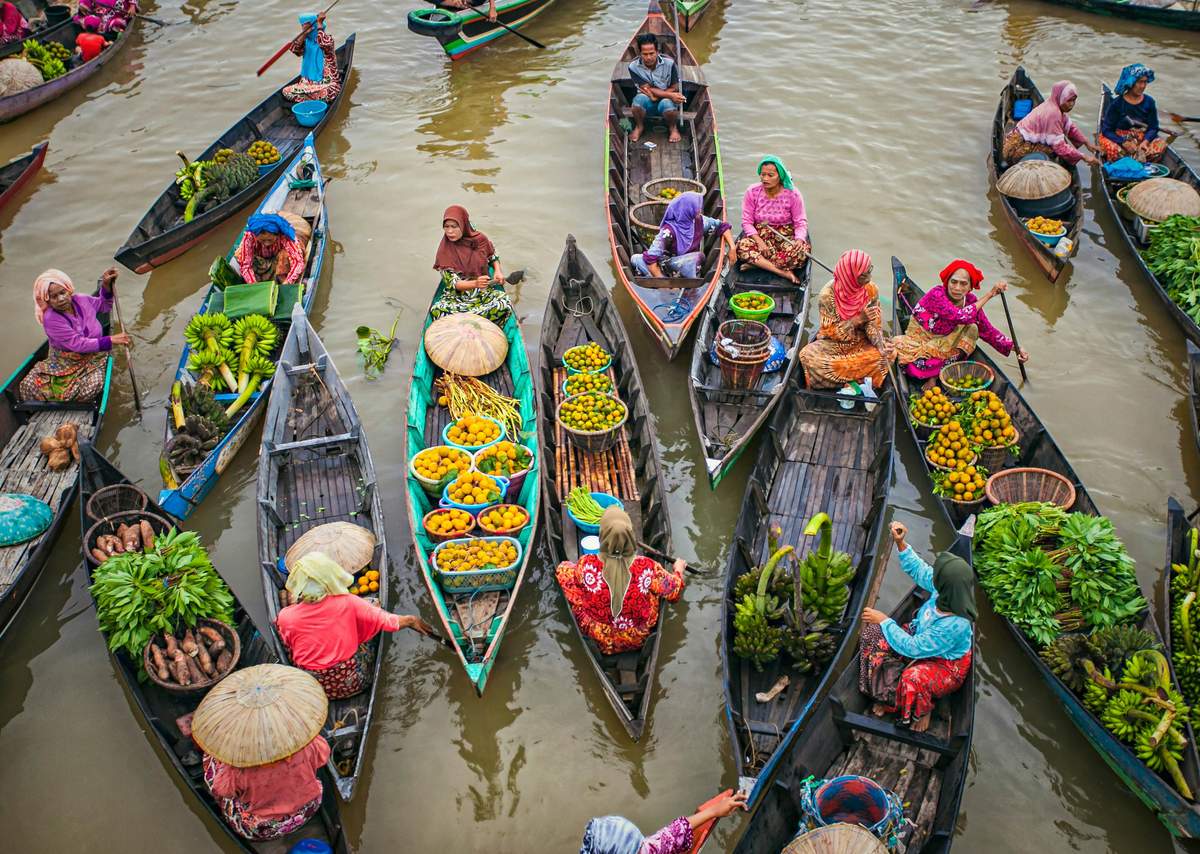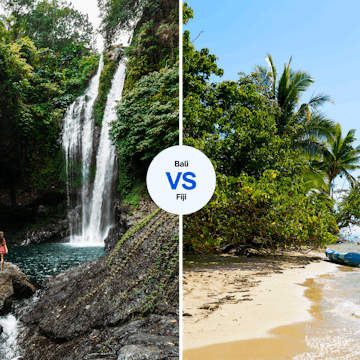
7 of the best road trips in Indonesia: scenic drives through the islands

Jun 5, 2025 • 10 min read

A roadside viewpoint in Flores, Indonesia. Vera Vita/Getty Images
Indonesia is one of the most diverse countries in the world, with wonders galore just waiting to be discovered. It would take a lifetime to explore the countless islands in this vast archipelago, but a self-drive road trip through the best parts of one or more of the 38 provinces will give you the freedom to enjoy the mesmerizing beauty of the lush rainforests, wildlife, beaches, far-flung villages, and incredible volcanoes, while meeting the local people and experiencing a wide range of different cultures and cuisines.
While driving in Indonesia may be daunting at first, it’s also highly rewarding. Here's our pick of the nation's best driving routes along with some tips on what to expect on the road.

1. Bali’s Lake District
Best for a leisurely drive through spectacular scenery, culture and nature
Seminyak – Munduk; 76km (47 miles); one day
Head to the lakeside village of Bedugul through scenic rice fields with views of the mountains stretching from Batukaru to Agung. Wander through the cool and tranquil Bali Botanic Garden, and visit Bukit Mungsu Market, known for its handicrafts and fresh produce. Stop at the mystical Pura Ulun Danu Bratan, a temple that appears to float upon the lake, purchase some of the locally-grown strawberries and continue northwest up a steep winding hill, where roadside monkeys frolic.
At the top, turn left towards Munduk, following the rim of the ancient caldera, which guards the northern shores of the twin lakes of Buyan and Tamblingan. Lookouts with bamboo platforms, swings, nests, and other innovative structures invite you to pose for enviable Instagram photos above the lakes. Continue towards the pretty village of Munduk, set between orange groves, fields of blue hydrangea and hedges of pink bougainvillea. Break for a cup of freshly harvested coffee at a hilltop cafe, complete with a breathtaking panorama of jungle, valleys, and the distant north coast. Take a pleasant walk along a clove-lined path to the refreshing Munduk Waterfall.

2. West and Central Lombok
Best route for exploring Lombok
Kuta – Sembalun; 197km (122 miles); allow at least three days
Starting from Kuta, head west to Pantai Selong Blanak. Here, the green waves are perfect for beginner surfers, and at sunset watch as buffaloes are herded along the shore. Travel north to Banyumulek, a traditional pottery village to see the artisans at work, and continue to the urban sprawl of Ampenan, Mataram, Cakranegara and Sweta. Visit Sekarbela to shop for high-quality pearls, and then on to Senggigi, from where the roller-coaster road winds around steep headlands and sheltered bays, with views of the famous Gili Islands. At Anyar, drop inland to Bayan to admire Lombok’s oldest mosque, crafted in riverstone, bamboo and thatch.
Stay in Senaru; be sure to visit the traditional Sasak village of Dusun Senaru. Rise early to watch the sunrise over Gunung Rinjani followed by a gentle hike to the waterfalls of Sindang Gila and Tiu Kelep, where you can swim in the deep river pool. Follow the snaking mountain road in a southeasterly direction through dramatic scenery to Sembalun, where you should spend at least a couple of nights. Unsullied by streetlights, the skies here offer magnificent stargazing. Wake early again for sunrise, and spend some time trekking the Rinjani National Park. Rest assured, the challenging volcano climb is not the only hiking route here.

3. Southwest Sulawesi
Best journey through ever-changing scenery
Makassar – Tana Toraja; 328km (204 miles); three days
Departing from bustling Makassar, witness the evolving architecture of traditional houses as you progress north. An hour’s drive will bring you to the karst landscape of Rammang Rammang Village, against a majestic Jurassic backdrop of towering limestone cliffs overgrown with dense vegetation. Board a simple canoe, glide along the Puteh River and embark on a soft trek to Passaung Cave with its ancient cave paintings, depicting scenes of hunting, rituals and daily life. Stay a night or two, absorb the unique atmosphere and meet the local people. There’s plenty more to see including Hand Palms Cave, Bulu Barakka Cave, Bidadari Lake, and Kampung Berua, a remote village of stilt houses.
When you're ready, continue north through stunning terrain to the landlocked regency of Tana Toraja, but take your time, stopping en route to visit towns and tropical forests. Reaching Tana Toraja, you will discover an intriguing culture, shrouded in mystery and the belief that death is not the end but merely a transition to the afterlife. The residents live alongside their deceased loved ones, often for many years, until their grand and elaborate funeral ceremonies. Visit the tombs in the high rocky cliffs, and stay in one of the ancestral houses, characterized by their distinctive boat-shaped roofs.
Planning tip: Aim to be there during the funeral season, between July and September, when there will be ceremonies, processions and animals will be sacrificed to honor the dead.

4. Trans-Flores Highway
Best route through west and central Flores
Labuan Bajo – Kelimutu; 470km (292 miles); five days
After cruising through the marvels of Komodo National Park, take the road southeast from the busy port of Labuan Bajo, stopping at the hilltop village of Cara for an awe-inspiring view of the iconic lingko or spider-web rice fields. Overnight in Ruteng and continue to Bajawa, home to the Malanage Hot Springs where you can sit under a hot-water waterfall for an invigorating natural massage. Spend two or three nights in Bajawa, enjoy the crisp mountain air and the amazing coffee. Hike the mountain trails or summit Mt Inerie, the island’s highest volcano.
Step back in time as you explore the mesolithic village of Bena and then progress to Boawae, another traditional village, which rests under the gaze of Mt Ebulobo. Stop at the blue stone, black-sand beach of Nangapanda. Base yourself in the small town of Moni for the highlight of this trip: ascending Kelimutu volcano at sunrise to see the three, surreal crater lakes, which independently shift colors, alternating between green, red and blue. This rare geological phenomenon is due to chemical reactions from the minerals in the lakes, triggered by volcanic gas activity. From the parking area, climb the steps to the top for an eye-popping view of all three lakes. Stay on to explore Kelimutu National Park and visit the white-sand Koka Beach.

5. Spice island of Tidore
Best one-day motorcycle drive around an island's history
Circumnavigation of the island from Rum Village; 48km (30 miles); one day
The spice trade made the island-sultanate of Ternate, and its neighboring rival, Tidore, the two most powerful territories in medieval Maluku. They were once the world’s only source of cloves, through which their rulers became among the wealthiest and most powerful sultans in the region. From Bastion Harbor in Ternate, you can charter a boat and speed across the strait to Tidore’s Rum Pier in 15 minutes. The larger of the two islands, but with a population only one-third of the size, Tidore has no major urban centers and, in contrast, is dotted with small villages. Rent a motorcycle at the wharf, and relish the freedom of circling the island’s coast at your own pace.
Tidore’s single-story houses are rendered in every fruity-flavored milkshake color from banana to blueberry, with a few gem-like hues whisked in for good measure. Visit the Sultan’s Palace and the ancient Spanish and Portuguese forts, filled with ghosts and untold stories. The east coast forts offer wonderful views across the sea towards Halmahera. At Soasiu, detour inland to a scenic viewpoint at Balibunga amid the nutmeg plantations. Or drive through acres of clove trees under the peaceful gaze of Mt Kiemtabu's pyramid-like volcanic cone that dominates the entire island leaving only a narrow coastal strip.
Planning tip: Check your travel insurance. Usually you will only be covered if you have a full license to drive a 125cc motorcycle in your home country.

6. East Sumba
Best tour of Sumba’s east coast
Waingapu – Puru Kambera Savannah – Walakiri Beach; 122km (76 miles); one day
On Sumba, an island of shamans, ancestor worship and native horses, begin your journey at Waingapu City, and head north, following the coast road to Puru Kambera Beach. Here, shaded by casuarina pines, the white sand stretches as far as the eye can see. Drop inland in a southerly direction to the vast grassland of Puru Kambera Savannah. This is the domain of the island’s famous sandalwood ponies. Continue south to Tanggedu Waterfall. It’s a 35-minute trek to reach these mighty falls, which cascade over the limestone rock from about 8m (26ft) with deep pools below.
Double back to the coast, retracing your journey as far as Waingapu and head onwards to the weaving village of Prailiu, known for its traditional Sumba houses, huge megalithic burial stones, splendid warp ikat textiles, cultural ceremonies and friendly people. Head further east, enjoy glorious sea views and stop at viewpoints. Visit another beautiful beach, Pantai Londa Lima with its iconic, rustic pier. Continue east to Walakiri Beach aiming to be there late afternoon for a breathtaking view of the dancing mangrove trees, silhouetted against the sunset. This is one of the most photographed sights in Sumba.
Local tip: There's a lot to see in a day. If you do decide to stay over, you won’t find much in the way of accommodation outside of the tourist centers.

7. Volcanic East Java
Best for a volcanic adventure
Banyuwangi – Malang; 336km (209 miles); three days
From Banyuwangi, head northwest to Kawah Ijen, stop at Jagir Waterfall. Taste the local produce at Kemiren Coffee Plantation. Hike the well-trodden track to Ijen Crater, where a mysterious milky aquamarine lake, located at the core of a reserve that spans the slopes and summits of three volcanoes, is the site of a labor-intensive sulfur mining operation. Avoiding the main highway, continue west to Bondoloso, overnight in Jember. Skirting the southern and western sides of Mt Argopuro, take the backroad via Kaliduren to Klakah. Entering the Bromo Tengger Semeru National Park, you’ll be met by a surreal landscape of volcanic plains and towering mountains. Visit nearby Madakaripura Waterfall.
Overnight in Bromo and rise early to witness the otherworldly beauty of Mts Batok, Bromo and the towering Semeru at sunrise. Descend into a vast volcanic desert and stare down into Bromo’s rumbling, steaming abyss, dubbed the Gates of Hell. If you’re on a motorcycle, traverse the massive Sand Sea, and drive up the almost-vertical western flank of the Tengger Caldera. Follow a single-track ridge road west between valleys with steep sides flourishing with cool-weather crops. Alternatively, if you’re tripping the main roads, visit Tumpak Sewu Waterfall. Continue through the countryside to Malang with its lovely colonial architecture, and don’t miss Kampung Pelangi Jodipan, the rainbow village.
Planning tip: You'll need to bring sturdy footwear and warm clothes for this volcanic adventure.

Tips for driving in Indonesia
Traffic in Indonesia can be heavy, chaotic, unpredictable and very overwhelming. Road rules are not generally enforced and there are many inexperienced or careless drivers. Drive on the left-hand side of the road. In the towns and cities, you'll encounter motorcycles and bicycles carrying cumbersome items and more than one passenger, bemos (minibuses), food carts stopping without warning, and vehicles cutting you off. On the quieter routes, dogs and chickens, cracks, loose gravel and potholes will become your hurdles. Motorcyclists will pull out in front of you without looking and pass you on the inside. You must also hold an international driving permit. Make sure you have a durable vehicle and enough fuel when off the beaten track.
In general, subject to the unpredictable effects of climate change, the best time for a road trip in Indonesia is during the dry season between April and October. North of the equator, in Tidore, you’ll find clear skies from November to March.















